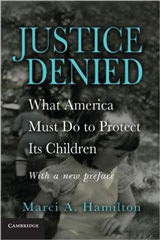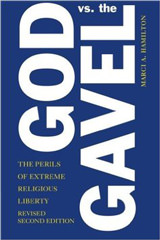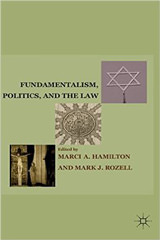I simply cannot wrap my head around the fact that the United States Supreme Court may soon be composed of six Catholics (Chief Justice John Roberts and Justices Clarence Thomas, Samuel Alito, Brett Kavanaugh, Sonia Sotomayor, Amy Barrett (if confirmed), one Justice who was raised Catholic but may now attend an Episcopal Church (Neil Gorsuch), and two Jews (Elena Kagan and Stephen Breyer).
First, the newly configured Court will reflect less than a quarter of the country’s religious landscape, according to the Pew Research Center, if we include Gorsuch in the Catholic cohort. Catholics make up 20.8% of the American public, while Jews constitute 1.9%, which means as a group the Justices will reflect a mere 22.7% of the country’s faith experience. There are more Evangelical Protestants, 25.4%, and more religiously unaffiliated believers—22.8%—than Catholics and Jews together.
Alternatively, if Gorsuch is counted as a Mainline Protestant, the Court still reflects only 36.4% of the population of the United States. And 2/3 of the Court is one faith, which reflects only 20.8% of the population. To be sure, there was a time when white Protestant males were the sole religious believers on the Court. Yet, that religious hegemony was also unfortunate in light of the religious diversity of the country.
Second, has anyone in Washington noticed that the Catholic Church has been undergoing a scandal of extreme proportions over the last twenty years? To state it as a fact: the Church’s hierarchy is responsible for shielding and empowering child sex predators around the globe. As I have said many times before, I eagerly await one President or one member of the U.S. House or Senate with the guts to utter the phrase, “clergy sex abuse,” let alone hold a hearing or establish a Commission to study the issue. Leading child protection organizations have joined forces under the name “Keep Kids Safe,” and are asking both presidential candidates to embrace such a mission. (Full disclosure: my organization, CHILD USA, is a part of this movement).
Ireland, Australia, and the UK have held hearings and published in-depth studies of the issue, while Washington simply whistles while it works. The Australian example is particularly admirable. The only institution-based sex abuse that has garnered any of Washington’s attention is the abuse in the Olympic community. How do the bishops continue to wield sufficient political power to pack the United States Supreme Court while under the microscope for destroying so many children and families?
Now, there is a simple, political explanation that can be summarized with one name: Leonard Leo, of the Federalist Society. A self-professed devout Catholic himself, he calls Justice Thomas a friend and is responsible for pushing Roberts, Alito, Gorsuch, Kavanaugh, and now Amy Coney Barrett. Perhaps that is the only fact we need to know to understand the composition of this Court.
But I also think the disconnect between the composition of the Supreme Court and the rest of the United States is also a function of the majority of Americans endorsing greater civil rights for the oppressed, while a minority holds tight to a traditional set of values. The courts are the last haven for those who have lost the culture wars.
The Rise of the Vulnerable Against the Entrenched Powers-that-Be
The twenty-first century is yielding an awe-inspiring rise of the vulnerable against their oppressors: child sex abuse victims are connecting and challenging venerable institutions that let them suffer, from the United States Olympic movement to the Catholic Church to the Boy Scouts to the sex trafficking operation of the rich and power-connected Jeffrey Epstein, and many more. Indeed, there is a healthy push for the civil rights of children generally. There is the Black Lives Matter movement demanding the right to be treated humanely and equally by law enforcement. There is the LGBTQ movement asserting the right to be treated with dignity in marriage, employment, and the marketplace. There is the #MeToo movement, which has featured women rising against their powerful harassers like Harvey Weinstein. Every one of these movements enjoys the support of a majority of the American public.
Then there is the conservative evangelical and Catholic movement, which has been pressing hard to entrench “traditional” values as they battle women’s reproductive rights and gay rights. They tend to focus on Roe v. Wade, but as James Dobson’s comments below show, they are invested in far more than stamping out women’s right to choose an abortion. They have been soundly defeated on cultural issues when it comes to public opinion, but they now seek to shore up their power through the Supreme Court.
In 2015, a quite different Supreme Court than the one we are about to experience, held that same-sex marriage is constitutionally protected in Obergefell v. Hodges. In response, Focus on the Family’s founder, James Dobson, declared that they had lost the culture wars. In his words:
I had a black cloud over me after June 26, when that decision was handed down, . . . And [as] I was contemplating this foreboding, this black cloud, it hit me like a ton of bricks. … That decision is not really about gay marriage. It’s not. It’s about everything else. It’s about the entire culture war.
It’s about control of the public schools and it’s what happens in universities . . . . It’s about the economy and it’s about business and it’s about the military and it’s about medicine. It’s about everything. We lost the entire culture war with that one decision. The gay marriage thing was just part of it, but it’s going to touch every dimension.
He was, of course, correct. They had lost the culture war on abortion and contraception, with a majority of the American public supporting the former, and an overwhelming majority supporting the latter, as I discussed here. He is also correct that they lost on same-sex marriage at the Supreme Court and amongst the public with over 60% of the American people approving of it, as you can see here and here and here. I also agree with him that Obergefell signaled a society-wide shift.
So what do you do if you have lost the American public on the issues you care most about, and you identify first and foremost as religious? If you are lucky enough to elect a President who represents a minority of the people, you pack the Supreme Court (and the courts generally) with those you trust to double down on religious “liberty” to find a way for your fellow believers to be able to reject what the American people have chosen as just and fair. You open the door to permit discrimination against women and LGBTQ by religious business owners and believers, as recent Supreme Court opinions have. Religious lobbyists have already delivered to conservatives the tool they need to do this: the “super statute” Religious Freedom Restoration Act, as Justice Gorsuch dubbed it in Bostock v. Clayton County, and as I explained here and here.
You also select Justices who will continue to scale back the Establishment Clause, if your goal is to empower the religious at the expense of the public. This is evident in the push to increase the power of religious entities to receive government funding without strings attached. This movement to water down the limits of the Establishment Clause on government funding for religious entities is already in motion as evidenced by the decision in Espinoza v. Montana Department of Revenue last Term. The next case the Court will hear in this canon is Fulton v. Philadelphia, which asks the question whether a city can deny funding to a religious adoption agency if it violates the city’s law against LGBTQ discrimination by refusing to place children with gay couples.
For those who root for David in the Bible story, David vs. Goliath, and who support the vulnerable now rising up, from child sex abuse victims to LGBTQ and people of color, and those who believe that people with power tend to abuse it (along with the Framers of the Constitution), the congealing Supreme Court is concerning. It is a threat to justice and morality.
The Two Pathways Forward in Response to a Court Reflecting the Values of Only a Minority of the U.S.
There are two pathways forward, but they are only available if the Democrats prevail in November. First, as I have said multiple times, RFRA should be repealed, or at least amended so it is not a pathway to discrimination or harm. There should be no RFRA carve-out of Title VII, and in particular it should not be available to for-profit corporations. Nor should religious liberty ever be heard as a defense to the sexual abuse of children, or adults for that matter.
Second, it is time to enlarge the Court. Its numbers have fluctuated from 6 to 10 over time, and there is no constitutional limitation. Nine is neither talismanic nor magical, and, by law, the size of the Court is up to Congress.
Amy Coney Barrett has not yet been confirmed, and I have no doubt the hearings will be contentious. Regardless of this one candidate, though, all Americans need to understand the mechanics that have built this out-of-step Court. A lot more is at stake than just Roe v. Wade. Everyone’s civil rights are at risk.









